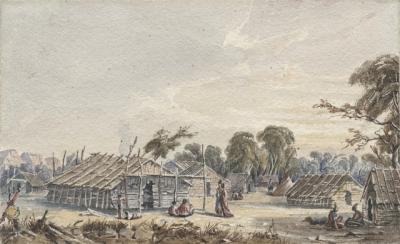 "Whenever, the course of a daily hunt, the hunter comes upon a scene that is strikingly beautiful, or sublime; a black thundercloud with the rainbow's glowing arch above the mountain, a white waterfall in the heart of a green gorge, a vast prairie tinged with the bood-red of the sunset; he pauses for an instant in the attitude of worship. He sees no need for setting apart one day in seven as a holy day, because to him all the days are God's days."
"Whenever, the course of a daily hunt, the hunter comes upon a scene that is strikingly beautiful, or sublime; a black thundercloud with the rainbow's glowing arch above the mountain, a white waterfall in the heart of a green gorge, a vast prairie tinged with the bood-red of the sunset; he pauses for an instant in the attitude of worship. He sees no need for setting apart one day in seven as a holy day, because to him all the days are God's days."
Ohiyesa (Dr. Charles Eastman), from The Soul of the Indian, 1911.
According to many, the area now known as Minnesota has been called "home" by Dakota people for thousands of years. For hundreds of years the Santee (or Eastern) Dakota moved their villages and varied their work according to the seasons. They spent the winter living off the stores of supplies built up during the previous year. Women gathered wood, processed hides, and made clothes while men hunted and fished. In the spring, villages dispersed and men left on hunting parties, while women, children, and the elderly moved into sugaring camps to make maple sugar and syrup. During the summer months families gathered in villages and men hunted and fished while women and children cultivated crops such as corn, squash, and beans. Once the corn had been harvested, families focused on gathering wild rice along the rivers. In autumn, families moved to the year's chosen hunting grounds for the annual hunt. This traditional lifestyle of communal support was the basis for Dakota society and culture.
Read more about Dakota values in Beginning Dakota/Tokaheya Dakota Iyapi Kin and Dakota connection to the land at the Bdote Memory Map.
Anderson, Gary Clayton. Kinsmen of Another Kind: Dakota-White Relations in the Upper Mississippi Valley, 1650-1862. St. Paul, MN: Minnesota Historical Society Press, 1997.
Deloria, Ella. The Dakota Way of Life. Sioux Falls, SD: Mariah Press, 2007.
Deloria, Ella. Speaking of Indians. Lincoln, NE: University of Nebraska Press, 1998.
Eastman, Charles Alexander. The Soul of the Indian. Houghton Mifflin: Boston & New York, 1911.
Gibbon, Guy. The Sioux: The Dakota and Lakota Nations. Malden, MA: Blackwell Publishing, 2003.
Oneroad, Amos E., and Alanson B. Skinner. Being Dakota: Tales and Traditions of the Sisseton and Wahpeton. St. Paul, MN: Minnesota Historical Society Press, 2003.
Spector, Janet D. What This Awl Means: Feminist Archeology at a Wahpeton Dakota Village. St. Paul, MN: Minnesota Historical Society Press, 1993.
Waziyatawin. Remember This!: Dakota Decolonization and the Eli Taylor Narratives. Lincoln, NE: University of Nebraska Press, 2005.
Waziyatawin. What Does Justice Look Like? The Struggle for Liberation in Dakota Homeland. St. Paul, MN: Living Justice Press, 2008.
Websites
Primary




